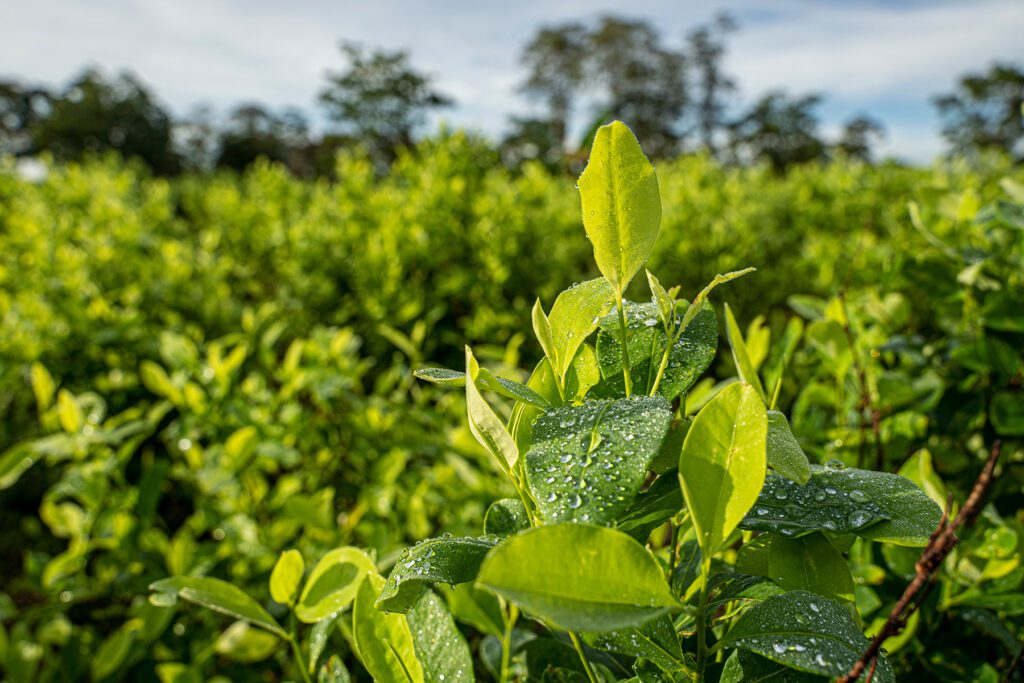The Secret History of Coca
T
he difference between coca leaves and cocaine, a Peruvian friend once quipped, is the difference between traveling by mule and jet plane. A clever line, but one that misses an essential point. The effects of the leaves and the drug are not comparable. To equate coca with the raw alkaloid is, in fact, as misguided as suggesting that the delicious flesh of a peach is equivalent to the hydrogen cyanide found in every peach pit. Yet for more than a century, this has been precisely the legal and political position of nations and international organizations throughout the world.
Since the adoption by the United Nations of the 1961 Single Convention on Narcotic Drugs, no fewer than 186 countries have signed an international treaty that both demonizes the traditional use of coca and calls for the complete eradication of the plant. Among the original signatories were three Andean nations — Colombia, Peru, and Bolivia — where coca, revered to this day, has been used beneficially, with no evidence of toxicity or addiction, for at least 8,000 years. The medicinal, nutritional, social, and spiritual value of coca has been demonstrated time and again by anthropologists, botanists, and physicians working in the Andes and northwest Amazon. Those dominating the international agenda with clarion calls for the elimination of the plant have, by contrast, consistently done so without the slightest scientific or medical justification.
Such policies, in fact, only make sense when viewed through the ideological frame that led to their formulation — the toxic and indeed racist legacy of colonial elites and the disastrous half century of the failed War on Drugs. Efforts to deny the indigenous peoples of the Andes access to coca, as Smithsonian anthropologist Catherine Allen has written, are not analogous to outlawing, for example, beer in Germany, coffee in the Middle East, or betel chewing in India. They are acts of cultural genocide, just the latest assault in a clash of civilizations that began 500 years ago with the Spanish Conquest.
Mercifully, all of this may soon change. In 2009, Bolivia formally petitioned the U.N. Social and Economic Council (ECOSOC) to delete from the 1961 Single Convention on Narcotic Drugs language that explicitly called for the eradication of coca within 25 years. Leading the charge was Evo Morales, who three years earlier had upstaged history by becoming Bolivia’s first elected Indigenous president. Those who came before him — 64 presidents in 180 years — had all been scions of the business and land-owning gentry, the same educated elite that had dominated the country since its independence in 1825. Morales, by contrast, was Aymara, a trade union leader who had devoted his professional life to the well-being of families dependent on the legal harvest of coca in Chapare, a lowland province long targeted by U.S.-sponsored eradication efforts in the War on Drugs. In challenging the U.N., he became the first Latin American head of state to invoke coca as an essential symbol of the patrimony and well-being of his people.
Morales’ bold stand invigorated a long diplomatic engagement that, with Colombia joining Bolivia, finally led to the World Health Organization (WHO) in 2023 agreeing to conduct a “critical review” of the coca leaf, the results of which are to be announced this October, with final recommendations to be voted upon at the annual session of the U.N. Commission on Narcotic Drugs (CND) in Vienna in March of 2026.
Bolivia’s goal, as reiterated on March 10, 2025, by Vice President David Choquehuanca as he addressed the 68th session of the CND in Vienna, is to “liberate the sacred coca leaf from the dark world of crime and delinquency.” In categorizing coca as a Schedule 1 narcotic, he continued, along with heroin and cocaine, “the 1961 convention, without conclusive scientific evidence, committed an absurdity, an attack on the culture of life. After more than six decades of injustice, persecution, threats, violation of rights and complicit silence, Bolivia’s petition to the WHO will bring to light the scientific truth, a truth that our peoples have known for millennia.”
The Sacred Plant
COCA IS LESS A HIGH than a meditation. When travelers meet in the mountains of the southern Andes, they pause and exchange k’intus of coca, three perfect leaves arranged to form a cross. They then turn to face the nearest of the Apus, the protective mountain deities that hover over every community and direct the destinies of all those born in their shadows. With eyes lifted toward the summits, they bring the leaves to their mouths and blow softly, a ritual invocation that sends the essence of the plant back to the earth, the community, the sacred places, and the souls of the ancestors. The exchange of leaves is a social gesture, a way of acknowledging a human connection. But the blowing of the phukuy, as it is called, is an act of spiritual reciprocity, for in giving selflessly to the earth, the individual ensures that in time the energy of the coca will return full circle, as surely as rain falling on a field will inevitably be reborn as a cloud.
The etiquette of hallpay, the totality of the act of using coca — the exchange and salutations, the way one places the leaves in the mouth, the attitude of reverence and respect — in a very real sense defines what it means to be Runakuna, a child of Pachamama. Throughout the entire Andean world, as Allen writes: “One cannot function as a social being unless you partake in the ritual, and you must do it properly.” Nothing causes more offense than tourists who stuff their mouths with leaves, like horses eating hay.
Whether the leaves are taken in the presence of a friend or a stranger, alone or together with all the community, to chew coca, to hallpay, is to transcend self and become part of the social, moral, and spiritual nexus that in the Andes gives meaning to life. Coca alone makes possible direct communication with the divine, with some saying today that the first to taste the leaves was Santísima María, mother of Christ, who, according to legend, lost her holy child and chewed on the leaves to allay her grief. Thus, for the people of the Andes to be without coca is a form of social and spiritual death, an excommunication from existence itself.
The coca plant in Colombia (2023). Its leaves have been found to be high in calories, protein, carbohydrates, and several minerals.
Edinson Arroyo/picture alliance/Getty Images
The plant that inspired such devotion is a beautiful if delicate shrub, with small white flowers and fruits the size and color of rubies. The texture and shape of the leaves varies, for there are two cultivated species, each with two varieties. Erythroxylum coca var. coca is the classic leaf of the southern Andes, grown in the upper reaches of the tropical valleys that fall away to the Amazon, the harvest making its way to the markets of Cusco and La Paz. The coca of Colombia, Erythroxylum novogranatense var. novogranatense, is distinct. Adapted to hot, seasonally dry habitats and highly resistant to drought, it produces small narrow leaves of a bright yellowish green hue. Notably, the coca of the northwest Amazon, Erythroxylum coca var. ipadu, the source of mambe, is not derived from Colombian hayo; it more closely resembles the coca of the southern Andes, leading early researchers to suggest that cuttings or seeds had been carried downriver from Peru or Bolivia in pre-Columbian times. Finally, there is Erythroxylum novogranatense var. truxillense, grown today in the coastal desert valleys of northern Peru. With just a hint of wintergreen oil, this was the preferred coca of the Inca, not to mention the key ingredient in the secret formula of Coca-Cola.
Significantly, DNA analysis suggests that the progenitor of both domesticated species and all four varieties is Erythroxylum gracilipes, a wild species found along the length of the Andes in the lowland forests of the western Amazon. Such botanical sleuthing may seem arcane, but to have three highly valued cultigens (hayo from Colombian, ipadu or mambe from the northwest Amazon and coca from the montaña of Peru and Bolivia) derived independently from a common ancestor, with separate processes of artificial selection occurring thousands of miles apart, is an astonishing story of parallel invention, made all the more wondrous when the plants in question are revered throughout the entire range of the cultivated species as the very essence of the sacred.
All of which begs a question: What was it about coca that so powerfully drew the attention of those responsible for bringing it into cultivation? Not once, but on three occasions, along the mountain slopes of Colombia, again in the heart of the northwest Amazon, and still again in the montaña of Peru and Bolivia, humans tasted the supple leaves of a nondescript forest shrub and concluded that this plant, among all others, was worthy of their attention; that it clearly had something going for it. Their fidelity did not wane over all the generations, as coca was both domesticated and transformed. For at least 8,000 years, and across lands from Costa Rica to Chile and Argentina, people everywhere, though born of unique cultures and speaking distinct languages, embraced the leaves with reverence and zeal, not simply as an essential source of nutrients, but as the very embodiment of the divine, a messenger of the gods. Coca touched and transformed all.
That early humans were drawn to the physical properties of the plant comes as no surprise. When Harvard’s Tim Plowman and Jim Duke of the USDA conducted the first nutritional study of coca, in 1975, examining 15 nutrients found in the leaves and comparing their concentrations with the levels of the same nutrients in 50 common Latin American foods, they found that coca was higher than the average in calories, protein, carbohydrates, and several minerals. What’s more, they discovered that coca leaves contain a host of vitamins, more calcium than any other cultivated plant — especially useful for Andean communities that traditionally lacked dairy products — and enzymes that enhance the body’s ability to digest carbohydrates at high altitude, an ideal complement for a potato-based diet. To the disappointment of government officials and public-health authorities who had long demonized the plant, Plowman and Duke confirmed that coca leaves, as used traditionally today by no fewer than 9 million citizens of Colombia, Peru, and Bolivia, serve as a mild and benign stimulant that is beneficial to the health and highly nutritious.
Also on the trail of coca in the early 1970s was Dr. Andrew Weil, a graduate of Harvard Medical School with a profound knowledge of medicinal botany. Known today as America’s doctor, the country’s leading proponent of integrative medicine, Weil was among the first physicians to use coca himself, even while conducting preliminary medical studies among traditional cocaleros in both the Andes and northwest Amazon. He found that coca facilitates well-being, eases digestion, and demonstrably relieves the symptoms of altitude sickness, or soroche. The plant can be helpful in the treatment of rheumatism, dysentery, stomach ulcers, and nausea, with the leaves having a positive influence on respiration and a capacity to cleanse the blood of toxic metabolites, notably uric acid. Daily use of the leaves clears the mind, elevates mood, and tones and strengthens the digestive tract, enhancing the assimilation of foods, even while promoting longevity.
“Based on my studies over more than 50 years,” he notes, “I believe that coca has significant therapeutic potential and should be available here for medical use. In addition to its actions as a mild stimulant, rapid-acting mood booster, and remedy for gastrointestinal disorders, it has a notable effect on carbohydrate metabolism. It appears to help normalize blood sugar. As a Schedule 2 controlled substance, coca is legally available for medical use in the U.S., but there is no legal supply and I would like to see that change. As they say in the Andes, coca is a gift from the heavens, a plant intended only to better the lives of all people dwelling in all places on the earth.”
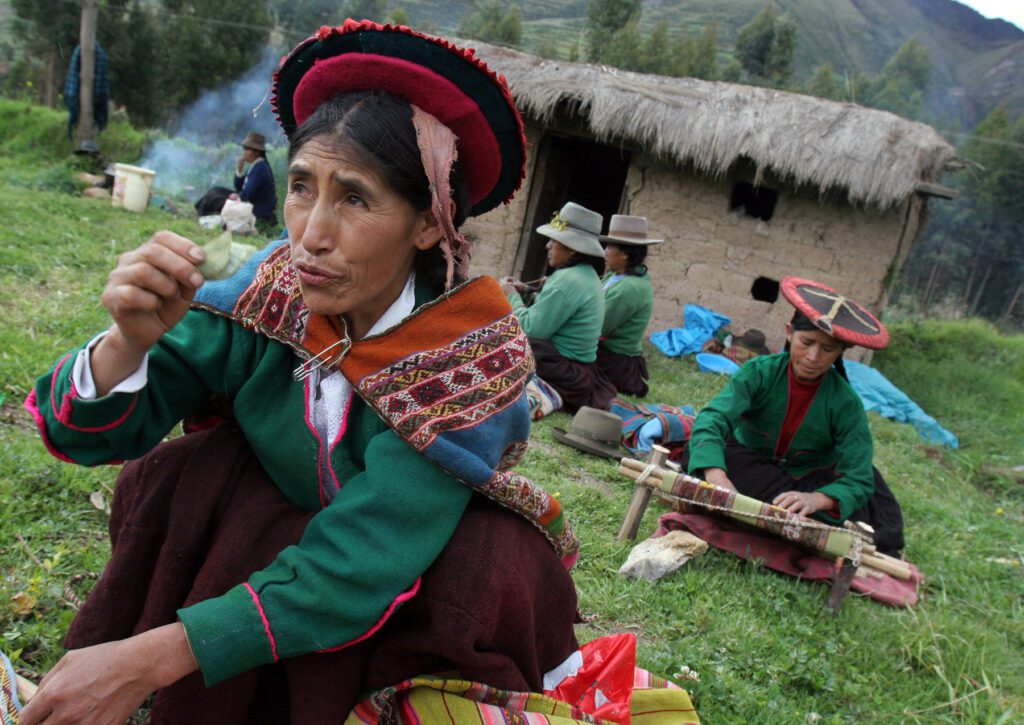
An Andean woman in Peru performs a coca leaf offering before starting her textile work (2008).
JAIME RAZURI/AFP/Getty Images
Here perhaps is the key to the plant’s sanctity. Useful and beneficial as coca may be both as food and medicine, such physical properties alone cannot account for its exalted place in the spiritual life of those living in the Andes today, not to mention all the cultures and civilizations that came before them. Coca has been universally heralded — an earthly gift bestowed upon the world by divine grace and fortune because it does much more than feed and heal our bodies. It allows us to live better lives, and for this we can thank its most mysterious attribute, the exquisitely subtle way its effects become manifest in daily and ritual use.
Arguably, the most insightful observations about the pharmacology of coca come from physicians and travelers in the late 19th and early 20th centuries — Europeans for the most part, scholars familiar with the hazards of cocaine but holding no bias when it came to the traditional use of the leaves. There is an ingenuous quality to their reports, suggesting a struggle to put into words the subjective effects of a natural stimulant that was really no stimulant at all, though of course, as one wrote, it clearly was.
J.T. Lloyd, who published A Treatise on Coca in 1913, wrote of the native porters of Popayán in southern Colombia: “After eating a simple breakfast, they would start with their heavy packs, weighing 75 to more than a hundred pounds, strapped to their backs. All day long they traveled at a rapid gait over steep mountain spurs at an altitude that to us, without any load whatever, was most exhausting. On these trips the Indians neither rested anywhere nor ate at noon but sucked their wads of coca throughout the entire day.” Lloyd concluded that coca was surely the key to their good health and good spirits. “Not only is it not harmful, it is said to provide nourishment for the body and to be useful in the treatment of many kinds of illnesses.”
The American physician, W. Golden Mortimer, author of History of Coca (1901), acknowledged coca as a panacea, noting its virtues as a medicine, tonic, and food. But what truly fascinated him was the subtlety of its mode of action. It was a stimulant to be sure, and yet, at the same time, its subjective effect on the body was unlike that of any other stimulant known to science. As the physician W.S. Searle wrote in 1881: “It is not a little remarkable that while no other known substance can rival coca in its sustaining power, no other has so little apparent effect. To one pursuing the even tenor of his usual routine, the chewing of coca gives no especial sensation, in fact the only result seems to be a negative one, an absence of the customary desire for food and sleep. It is only when some unusual demand is made upon mind or body that its influence is felt.… Those expecting some internal commotion or sensation are disappointed.”

Circa 1955: Bolivian coca leaves are laid out on burlap sacks to dry.
Evans/Three Lions/Getty Images
Andrew Weil captured this quality of the coca experience beautifully in his description of his first exposure to mambe while visiting the Cubeo in the Colombian Amazon in 1973. The effect of coca, he reported, was so subtle that it could not be compared with any other natural product similarly employed. His first taste of mambe occurred at night, leaving him with a good feeling “that lasted for some time after I had nothing more in my mouth; in fact, it never really ended but simply trailed off imperceptibly.” It was only in the morning, as he huddled with the men as they exchanged a calabash full of the delicate green powder, that he came to understand what all the fuss was about. “I found myself marching along in the column of Cubeos, swinging my machete, humming a tune, and feeling increasingly happy. The coca seemed stronger at this hour of the morning. Its warm glow spread from my stomach throughout my body. I felt a subtle vibrational energy in my muscles. My step became light, and there was nothing I wanted to do more than just what I was doing.”
The same qualities that draw our attention to coca today no doubt attracted men and women in the distant past. However they lived, they surely shared traits that mark us today, all the foibles and minor neuroses that define what it means to be human and alive. Existential malaise, the restless yearning for something new, dissatisfaction and indecision, even at times depression and despair, surely go hand in hand with consciousness. Just as death is the price we pay for the glory of being alive, so such modest yet chronic afflictions are the cost of being sensate and aware. There is no reason to assume that the ancient peoples of the Andes were somehow free of the same mental obscurations that Buddhists have famously identified as the bane of the human condition.
To the contrary, they would have suffered much as we suffer and, like us, would have been powerfully drawn to any plant that offered relief, as coca surely does. They too would have been astonished by its subtle yet pleasant effects and its practical use. What man or woman, then or now, would not want to experience a sense of enhanced energy and mental clarity, a mild suppression of hunger, a gentle feeling of creative confidence, a lightness to one’s step lasting throughout the day, knowing that the source of your slight elevation of mood was a benign and highly nutritious leaf that has been revered by the peoples and cultures of South America since the dawn of civilization?
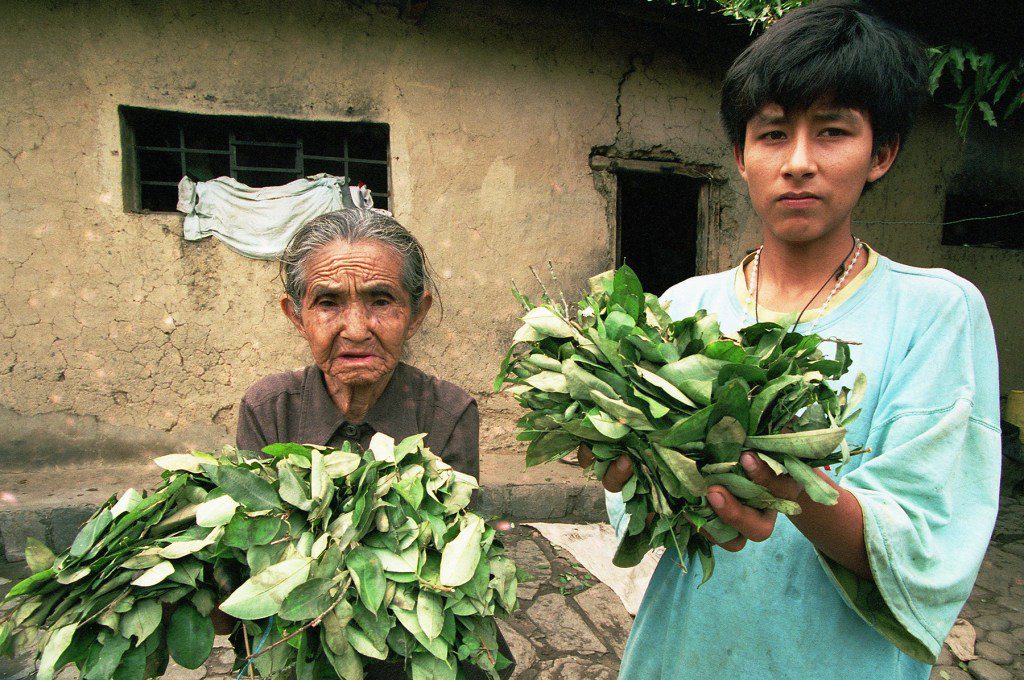
An old woman and her grandson showing their coca crop in the Andes, where coca farming is a lucrative cash crop for poor farmers. It is chewed by the native population as a medicine to treat fatigue, hunger, thirst, altitude sickness, and other ailments.
John van Hasselt/Sygma/Getty Images
What could be more welcome or promising in any era than a beneficial natural product that facilitates focus and concentration, even while inducing a subtle sense of contentment and well-being? Truth be told, coca is and has always been the ideal companion for any creative endeavor, be it the weaving of cotton and wool, the carving of stone, or the writing of digital code. Coca works, and it works for everybody, which is precisely why every culture and civilization that knew the plant deemed it to be sacred, deserving of veneration.
The Demon Plant
How then did such a plant, so beneficial and benign as a medicine, food, and mild stimulant, come to be classified among the world’s most dangerous drugs, condemned by international law as the criminal equivalent of heroin, fentanyl, and crack cocaine?
Morphine, derived from opium, was the first drug isolated from a natural product. The second was cocaine in 1860. Celebrated as a panacea, the ideal treatment for everything from morphine addiction to that scourge of the 19th century, female masturbation, cocaine revolutionized medicine as the first effective topical anesthetic; it remains essential to this day for nose, throat, and ear surgery.
For a time cocaine was everywhere, sold and celebrated in scores of commercial products. By 1890, however, with medical literature reporting more than 400 cases of acute toxicity brought on by the drug, cocaine had lost its luster. As the medical profession came to consider cocaine and morphine as equally dangerous, coca became associated with opium, and the public was led to believe that the ruinous effects of habitual opium use would inevitably befall those who regularly chewed coca leaves. Thus, a plant that had been used safely and benignly for thousands of years was swept up in the same sanctions that criminalized the use of opium, morphine, and cocaine.
This explanation makes sense, but only to a point, for something far darker was in play. The American government had long demonized the plant. In Peru, programs to eliminate the traditional fields, supported by the United States, began 50 years before a black-market trade in the drug even existed. The real issue was not cocaine but, rather, the cultural identity and survival of those who traditionally revered coca. The call for eradication came from officials and physicians, Peruvian and American, whose concern for those who used coca was matched in its intensity only by their ignorance of Andean life and contempt for the very people they set out to save.
Critically, these were also the men who served on the commissions and wrote the reports that became the basis for laws and agreements that define international drug policy to this day. That these voices may still be heard — coming through their writing as they conflate personal opinion with scientific fact and pseudo experiments with actual science — is the scandal that lies at the heart of the coca story.
In the 1920s, as physicians and public health officials from Lima looked up into the Andes, they saw only abject poverty, illiteracy, poor health and nutrition, and high rates of infant mortality. With the blindness of class, prejudice, and good intentions, they searched for a cause. Since political issues of land, economic disparity, and raw exploitation struck too close to home, forcing them to examine the structure of their own world, they settled on coca. Every possible ill, every source of embarrassment to their bourgeois sensibilities, was blamed on the plant.
“Everything points to the conclusion,” wrote Vicente Zapata Ortiz, professor of pharmacology in the faculty of medicine in Lima, in 1952, “that the constant toxic condition produced by coca results in acceptance of the most wretched living conditions, which are the chief cause of the chewers’ deficiencies; and coca is therefore regarded as primarily responsible.”
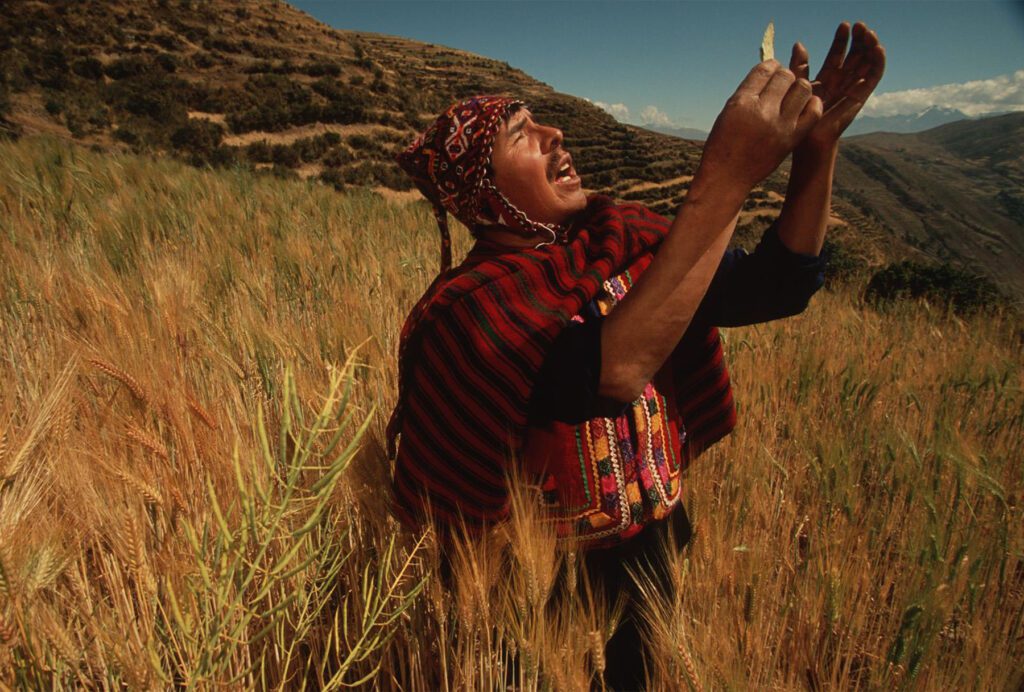
A man practices the act of Phukay. Turning to face the nearest apu, or sacred mountain, a man blows softly over the leaves, a ritual invocation that sends the essence of the plant back to the earth, the community, and the souls of the ancestors.
Wade Davis
Zapata Ortiz went on to characterize coca users as “apathetic, indolent, deficient in higher mental activity and subjective life … aimless, indifferent, and maladjusted” and, above all, resistant to learning Spanish, preferring in their ignorance the languages of their ancestors. “Where the consumption of coca is greatest, the percentage of illiteracy is high, and Quechua and Aymara are the prevailing languages”.
Carlos A. Rickets, who first presented a plan for coca eradication in 1929, described coca users as feeble, mentally deficient, lazy, submissive, and depressed. Another leading commentator, Mario A. Puga, condemned coca as “an elaborate and monstrous form of genocide being committed against the people.” Referring in 1936 to Peru’s “legions of drug addicts,” Carlos Enrique Paz Soldán, a doctor and university professor, raised the battle cry: “If we await with folded arms a divine miracle to free our indigenous population from the deteriorating action of coca, we shall be renouncing our position as men who love civilization.”
IN THE 1940s the push for eradication was led by Carlos Gutiérrez-Noriega, chief of pharmacology at the Institute of Hygiene in Lima. Considering coca “the greatest obstacle to the improvement of Indians’ health and social condition,” Gutiérrez-Noriega established his reputation with a series of dubious scientific studies, conducted exclusively in prisons and asylums, which concluded that coca users tended to be alienated, antisocial, inferior in intelligence and initiative, prone to “acute and chronic mental alterations” as well as other reputed behavioral disorders such as “absence of ambition.” The ideological thrust of his science was blatant. In a report published in 1947 by the Peruvian Ministry of Public Education, he wrote, “the use of coca, illiteracy and a negative attitude towards the superior culture are all closely related.”
It was largely as a result of Gutiérrez-Noriega’s lobbying that Peru in 1947, joined by Bolivia two years later, invited the United Nations to dispatch a team of experts to look into the coca problem. Leading the investigation, formally known as the 1950 ECOSOC Commission of Enquiry on the Coca Leaf, was Howard Fonda, vice president of both Burroughs Wellcome, the pharmaceutical giant, and the American Pharmaceutical Association, the industry trade organization.
Before heading to Peru, Fonda in a 1949 newspaper interview outlined the aims of the commission. Coca, he stated, was “definitely harmful and deleterious … the cause of the racial degeneration of many population groups and of the decadence which is obvious in many native inhabitants, and even the half-castes, of certain regions of Peru and Bolivia. Our studies will confirm the truth of our statements, and we hope to be able to submit a rational plan of action based on the realities of the situation and on experience in the field, to secure the total eradication of this pernicious habit.” Some weeks later, Fonda would repeat these assertions, word for word, at a press conference at the Lima airport, as the commission arrived in Peru to begin its investigation.
Fonda’s commission, consisting of two medical experts and two authorities in the management of drug-control issues, visited highland regions of both Peru and Bolivia, gathering information from military and government officials, medical personnel, academics, religious leaders, local authorities, and landowners. Absent from the conversation were the voices of the very subjects of the research. In three months in the field, the commission made no effort to engage the Quechua and Aymara communities through which they traveled. Their final report, some 200 pages in length, includes not a single testimonial from a traditional user of the leaves, an egregious omission that apparently gave no one pause. Fonda returned to New York in December 1949, convinced as ever, as the commission’s report concludes, that “from the social standpoint, the effects of chewing coca leaf are highly prejudicial both to the individual and to the nation.”
Closely associated with Fonda and formally serving in an advisory capacity was Pablo Osvaldo Wolff, chief of the addiction-producing drugs section of the World Health Organization (1949-1954). As a protégé of Harry Anslinger, the notorious anti-drug zealot at the head of the Federal Bureau of Narcotics, Wolff was part of the inner circle of control advocates that virtually dictated WHO policy at the time. His 1949 booklet, Marijuana in Latin America: The Threat It Constitutes, introduced by Anslinger, reads comically today, with language reminiscent of Reefer Madness. But in their day, Wolff and Anslinger were crusaders, deadly serious and not about to let facts get in the way of their opinions. Drawing a direct correlation between cannabis and crime, Wolff endeared himself to Anslinger by claiming without the slightest evidence to have identified 200 million cannabis addicts worldwide, each one a dire threat to American values.
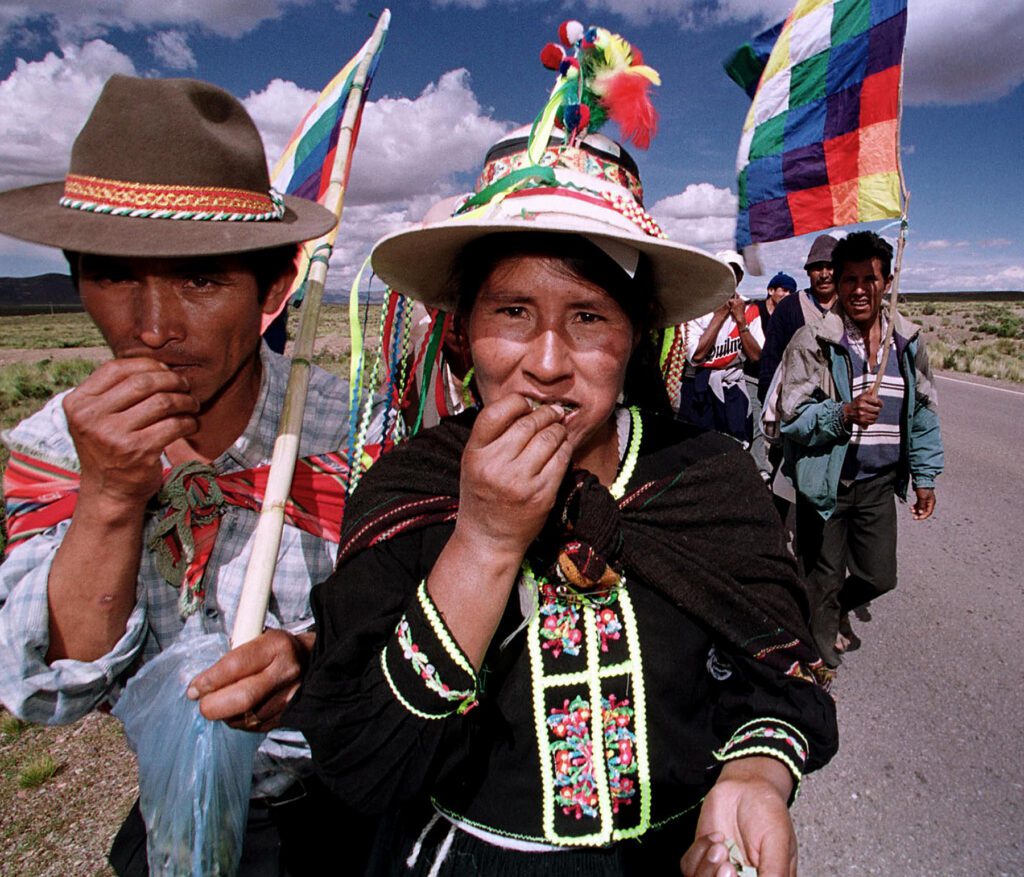
Farmers chew coca leaves while they walk to the Bolivian capital to ask the government to stop eradicating coca crop (2001).
GONZALO ESPINOZA/AFP/Getty Images
As secretary of the WHO’s Expert Committee on Drugs Liable to Produce Addiction, Wolff played a key role not only in crafting Fonda’s report, but in all decisions related to coca; more than any other individual he was responsible for the vilification and criminalization of the plant in the U.N. drug-treaty system. Given his influence, his public comments are telling, notably a 1949 lecture to the Royal Society of Medicine in London, on the eve of the commission being sent to Peru.
“The Indio who does not chew coca leaves is clear-sighted, intelligent, and lighthearted, willing to work, vigorous, and resistant to diseases; the coquero, on the contrary, is abulic, apathetic, lazy, insensitive to his environment; his mind is befogged; his emotional reactions are rare and violent, he is morally and intellectually anesthetized, social subdued, almost a slave. Moral degeneration accompanies the physical; lying is one of the outstanding characteristics, probably due to lack of moral equilibrium. Criminality is high, and barbaric forms of homicide can only be explained by a certain moral insensibility.
“We are convinced that coca-leaf chewing is a social evil; the chronic consumption of these leaves constitutes a social poison which undermines the physical and mental health of the population and lowers its moral and economic level.… The children of coqueros are markedly deficient in intelligence.…There is no doubt that the habit of chewing coca leaves is one of the most powerful reasons for the backwardness and misery of the Indian population … the last link in a chain of social and medico-social scourges, which include pauperism, bad housing conditions, deficient nutrition, rudimentary or completely absent education, alcoholism, tuberculosis, venereal disease and other infections, and promiscuity, to mention only the worst calamities and miseries.
“The remedy of the moment is gradual disintoxication of the native, diminishing the production as well as the consumption of coca by means of a suitable education; by abolishing the superstition of the magic action of coca and the cult of the leaves; by prohibiting initiation of young children in its use.… Only with skill and patience can coca addiction be abolished, but it can be done.… Christianized Indians no longer live in the former wretched conditions and thus show themselves physically and mentally capable of freeing themselves from coca-leaf chewing.”
Wolff was not alone in his views on coca or in his contempt for those who used and revered the plant. His attitude was in line with the consensus of his era, a time when urban elites ruled unchallenged over Andean countries that remained very much the home of conquerors and the conquered.
In 1948, the Colombian government declared the mastication of the leaves to be a “social evil,” criminalizing the trade in public markets and limiting coca sales to registered pharmacies and drug dispensaries. The country’s most prominent public-health official, Dr. Jorge Bejarano, appointed minister of health in 1947, summed up the fate of the cocalero: “To the physical degeneration must also be added the moral implications: Crime is high among these individuals. It seems that their minds only obey the force of instinct; and deceit, which is one of their sharpest features, is probably the effect of psychological imbalance due to the habitual use of coca.”
Bolivian health authorities, again with no scientific or medical justification, claimed that coca caused autism, not to mention “fantastic visions, disturbances of spatial perception … pseudo-hallucinations and true auditory and visual hallucinations.” A physician from Cochabamba blamed coca for “the mental decay and social inferiority of the Indian.” From Quito, Luis León, writing in the U.N. Bulletin on Narcotics in 1952, noted proudly that due to the historic disappearance of coca in Ecuador, “many entirely impartial sociologists who (had) studied the indigenous groups of Colombia, Peru, Bolivia and Ecuador, would not hesitate to admit the cultural superiority of the Ecuadorean Indian.”
Wolff stands out from his scientific peers not because he was unique in his rabid condemnation of coca, but rather because his crude certainties and pseudo-scientific exhortations were those of the very man singularly responsible for crafting the language of the U.N. documents and declarations that dictate international drug policy to this day. His authority, together with the political power of his mentor, Harry Anslinger, was very much at Howard Fonda’s side as the pharmaceutical executive and his team surveyed Peru and Bolivia in search of evidence that would confirm convictions they had already forged long before leaving New York.
Those who challenged their views were swept aside, be it Mortimer, the History of Coca author, or Carlos Monge, an advocate and professor at the Instituto Nacional de Biología Andina who celebrated the benefits of coca even while invoking José Hipólito Unánue, the most famous Peruvian physician of the 18th century, who had heralded the leaves as a panacea, the most powerful herb in a healer’s repertoire.
The academic writings of Wolff and his peers ooze conceit and contempt; in rebuttal they offer not scientific evidence but only personal opinion glossed in scientific jargon. Remarkably, in the midst of their hysterical efforts to purge the world of coca, none of these health officials did the obvious: Analyze the leaves to find out what they contained. Coca was, after all, a plant consumed every day by millions of men and women. A nutritional assay, which could have readily been initiated even as Fonda’s investigation was underway in 1949, was never done, and presumably for a good reason. No one was interested in knowing what the leaves contained, unprepared as they were to accept any evidence that might challenge their narrative. Tim Plowman and Jim Duke would famously reveal coca to be both benign and chock-full of vital nutrients, but their nutritional study came a generation too late to inform the bureaucratic and political process that led to the criminalization of the plant.
Not surprisingly, Fonda’s conclusions, published as the 1950 “Report on the Commission of Enquiry on the Coca Leaf,” condemned coca and recommended a 15-year phasing out of its cultivation. The report’s one heresy was the acknowledgment by the members of the commission that coca chewing “does not constitute an addiction, but a habit.”
Wolff made sure that this assertion was struck from subsequent reports in 1952 and 1954. Coca, he maintained, was the equivalent of cocaine, and it was this language that, in the end, informed Article 49 of the 1961 Single Convention on Narcotic Drugs, which consigned coca to Schedule 1, categorized among the most dangerous drugs known to society.
Wolff tolerated just one exception, Article 27 which legitimized “the use of coca leaves for the preparation of a flavoring agent, which shall not contain any alkaloids.” Coca-Cola alone would be free to import coca leaves to the U.S., as the company continues to do to this day, altogether well over a hundred metric tons a year. After processing at the Stepan Company in Maywood, New Jersey, the cocaine extracted from the leaves is legally sold to the pharmaceutical industry. The essential oils, flavonoids, and other constituents go into the beverage that is the foundation of a $300 billion global enterprise. The company doesn’t advertise its position as the only legal importer of coca in the country, but the leaves are the reason that Coca-Cola can legitimately lay claim to be, as its advertising slogan has long professed, the real thing.
FOR NEARLY 40 YEARS, even as the illicit trade in cocaine convulsed Latin America and much of the world, the status of coca remained unchanged and unchallenged. In 1992, in response to the global drug crisis, the WHO launched the most comprehensive study of cocaine use ever undertaken, with surveys conducted in 19 countries across five continents by 45 experts in the field. The preliminary report, contradicting years of official policy, unexpectedly affirmed that “the traditional use of coca leaves appears to have no negative health effects and has positive therapeutic, sacred, and social functions for indigenous Andean populations.” The report went on to encourage the WHO to investigate the therapeutic benefits of the coca leaf, as well as the impacts of repressive measures on specific individuals and populations of users.
This was not what the American government wanted to hear. Neil Boyer, representing the United States at the 48th meeting of the World Health Assembly in Geneva, in May 1995, denounced the WHO for “undermining the efforts of the international community to stamp out the illegal cultivation and production of coca.” The U.S. government, according to Boyer, was especially disturbed that the report claimed “that use of the coca leaf did not lead to noticeable damage to mental or physical health, that the positive health effects of coca leaf chewing might be transferable from traditional settings to other countries and cultures, and that coca production provided financial benefits to peasants.” Boyer then added a threat. “If WHO activities relating to drugs fail to reinforce proven drug-control approaches, funds for the relevant programs should be curtailed.”
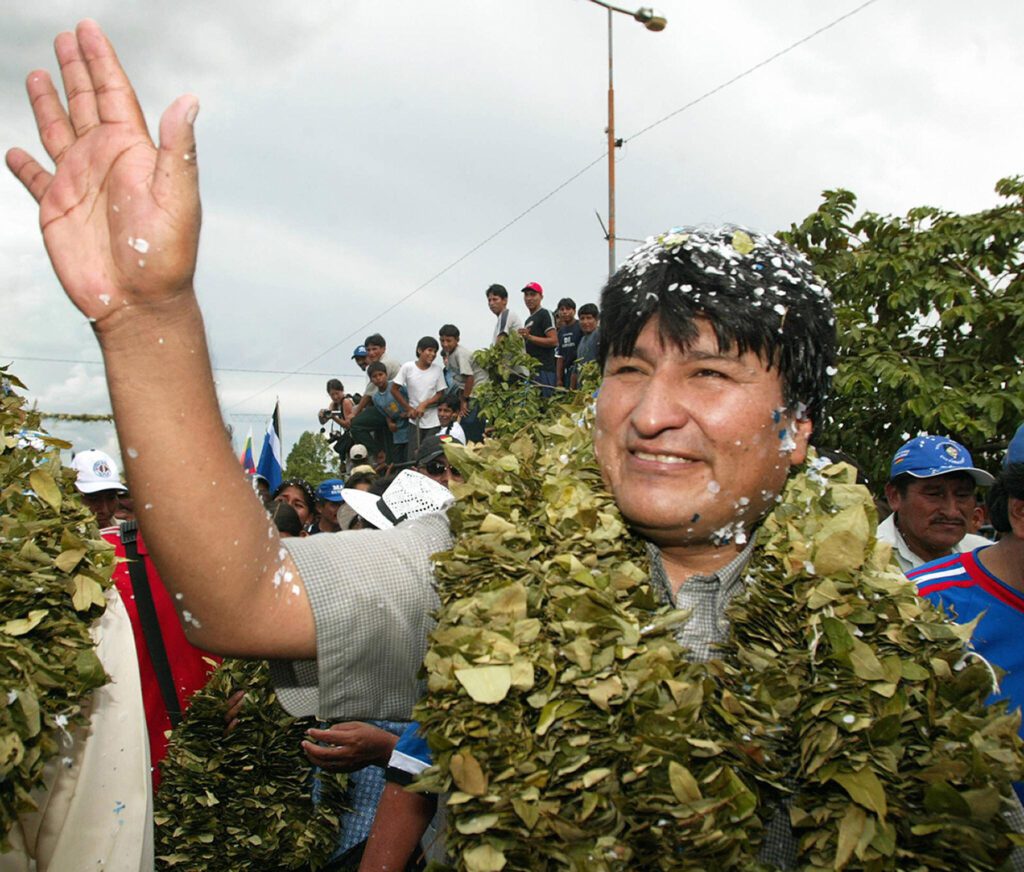
Bolivia’s president-elect Evo Morales wearing a garland made of coca leaves.
AIZAR RALDES/AFP/Getty Images
The United States, at the time the primary funder of the World Health Organization, used the full weight of its influence to ensure that the report would never be published. The official WHO position on coca remained unchanged, though the rationale became even more of a stretch. As noted in a 1992 report of the Expert Committee on Drug Dependence (ECDD), “The coca leaf is appropriately scheduled under the Single Convention on Narcotic Drugs, 1961, since cocaine is readily extractable from the leaf.”
Thirty years on, such reasoning falls flat. Drug cartels that have successfully shipped cocaine by the ton into the United States for nearly 50 years couldn’t care less about the legal status of coca leaves, for it has no impact on their business. With coca as a controlled substance, the cartels have thrived. Should coca leaves be liberated, illicit cocaine production and distribution will still be subject to all the criminal sanctions that exist by international treaty today. To suggest that the cartels might import coca leaves to extract cocaine makes about as much sense as suggesting that someone would import Dom Perignon to secure by chemical processing pure extracts of ethyl alcohol.
What is at stake are the rights of ordinary people to enjoy the benefits of the plant, and the legitimacy of drug policies originally informed by the bankrupt certitudes of men whose research was deeply flawed and whose convictions, as revealed in their writing, were both morally reprehensible and transparently racist.
Bolivian Vice President David Choquehuanca, speaking in Vienna at the 67th session of the U.N. Commission on Narcotic Drugs, left little doubt that in calling for the extermination of coca, the 1961 Single Convention on Narcotic Drugs violated the rights of Indigenous people, even while assaulting the cultural heritage of his nation. Joined by Colombia, Bolivia is demanding, in effect, that coca be liberated and recognized as the wondrous gift that it represents for all of humanity.
“No one”, as Choquehuanca said, referring to the illicit trade and the ongoing War on Drugs, “should confuse the life-creating energy of this sacred plant with the energy of the cult of death. The time has come for the liberation of coca as we build a drug policy based instead on the cult of life.”
The immediate challenge will be the integrity of the critical-review process, initiated at last by the WHO on Nov. 30, 2023. Should science prevail, in the words of Laura Sarabia, Colombia’s minister of foreign affairs, it “will prove that the coca leaf itself is not harmful to health.” That Andrew Weil and other authorities and vocal supporters of reform have been excluded from the review process because of their advocacy is disturbing. But in the end, the truth about coca will be difficult to deny.
The date to keep in mind is Oct. 20, 2025; the place, Geneva, where the final report will be presented at the 48th session of the Expert Committee on Drug Dependence. At that time, the members will debate three options. They could elect to do nothing, leaving coca still scheduled among the world’s most dangerous drugs. Alternatively, they might move coca to Schedule 2, as it is classified by American law. This category is restricted to medically useful substances that nevertheless can be harmful. As such, the leaves would remain subject to most of the restrictive provisions of the treaty, though it would permit physicians to prescribe the leaves.
The third and preferred option for advocates is to have coca descheduled, removed altogether from the shackles of the treaty, making coca freely available to all. Should the ECDD elect to liberate the leaves, the plant would still face bureaucratic hurdles. First, the 53 member states of the Commission on Narcotic Drugs would have to endorse the ECDD recommendation with a simple majority vote, likely to occur in Vienna in March 2026. That result would then be communicated by the U.N. secretary-general to all member states, the WHO, and the International Narcotics Control Board. At any point, politics could challenge the process. The United States, the most vocal and ardent opponent of reform, has formally left the WHO, but its pressure no doubt will be felt.
Still, more than 75 years after the United Nations first called for the abolition of coca, the prospects for those seeking to liberate the plant have never been brighter. If Bolivia and Colombia are successful in Vienna, it will be a stunning reversal of fortunes and a great boon for Latin America. Access to the leaves will stimulate scientific research that will objectively assess coca’s medical and therapeutic potential and benefits, with the ultimate goal of making available for all people a plant that promises to improve their well-being and ease the day-to-day challenges of their lives. A wide array of coca-based products will bring delight to consumers, even while supporting the more than 200,000 families in Colombia alone who grow the plant for a living, allowing them to restrict or even sever their ties to the cartels. The liberation of the leaves will undermine the black-market trade and reduce deforestation by freeing for cultivation lands long ago cleared and abandoned. Through taxation, it will generate for Colombia, in particular, the revenues that will allow a long-suffering nation to pay the price of peace, having drained its treasury for 50 years to cover the costs of a war only made possible by the sordid profits of prohibition.
For the people of Latin America, and indeed for good people everywhere, it is a dazzling prospect: An end at last to the war on coca. A stolen legacy returned to its rightful status. The sacred plant, long defiled, heralded, as in the time of the Inca and all the ancient civilizations of the Andes, as a gift of the gods.


